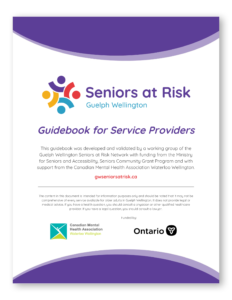Functional
This section defines functional decline as the loss of one’s physical and/or cognitive abilities. If functional decline is a result of aging it can be referred to as “age-related functional decline.”
There are many types of common age-related functional decline
- Changes in vision (macular degeneration, cataracts, and glaucoma)
- Hearing difficulty
- Issues with balance and gait
- Memory problems, including dementia
- Frailty or bone weakness (osteoporosis)
Table of Contents
Next we review five risks associated with physical or cognitive decline
Screening tools and risk management resources are available in each section below.
Self-Neglect
Self-neglect occurs when an older adult is unable or unwilling to effectively meet his or her own needs for food, clothing, shelter, medical care, safety, and personal hygiene, and lacks the insight into the consequences or harm that can subsequently result. Older adults who neglect themselves typically live in conditions of extreme isolation, filth, and squalor. They often hoard and have rodent, insect infestations and may possibly risk eviction as a result of safety hazards and complaints from neighbours (BCMJ, 2011).
Self-Neglect Resources & Links
Refer to the section on Consent & Capacity for more information.
An interdisciplinary approach is useful in managing situations of self-neglect. Often there is a question of cognitive and functional decline and capacity assessments specific for areas of personal care and shelter may be required (Refer to the section on Consent and Capacity for more information). Additionally, some older adults do not have the social support, finances or ability to seek assistance from other services which may lead to self-neglect. Clinicians frequently debate whether self-neglect represents a medical or social concern, particularly if dementia or severe mental illness is not present. If an older adult who is at risk as a result of self-neglect is incapable and ill, it would be negligent for health professionals not to intervene (BCMJ, 2011)
The goals of intervention in cases of vulnerability are to promote autonomy, ensure safety, reduce morbidity and mortality, maximize function, and improve quality of life (Pavlou M., Lachs M., 2008). Individuals should be offered support and assistance such as home care, day programs, ongoing medical follow-up, housekeeping, meal delivery, and transportation programs. Hospitalization and facility placement may be required, depending on the needs of the individual. The least invasive measures should always be used in accordance with the individual’s previously expressed wishes and values. Service providers should include the older adult in decision making as much as possible.
Falls
Falls are one of the leading causes of hospitalizations among older adults and also the main reason older adults lose their independence. It is important that as service providers we are screening older adults for changes in balance, gait and mobility and engaging them in the conversation (Stats Canada, 2014).
Falls Resources & Links
Resources for your clients at risk of falling:
Risk Factors
Most falls occur as a result of compounding factors that combine and overwhelm an older person’s ability to maintain or regain their balance.
Risk factors typically represent a complex interaction of the following conditions (Public Health Agency of Canada, 2014):
- Biological: acute illness, balance and gait deficits, chronic conditions, cognitive impairments, low vision, reduced physical fitness
- Behavioural: assistive devices, fear of falling, footwear and clothing, excessive alcohol, previous falls, diet, medications
- Environmental: living environment; community hazards, weather and climate
- Social and Economic: social networks, socio-economic status
Understanding what puts an older adult at risk of falling is a critical step in reducing falls and fall-related injuries among older adults (Public Health Agency of Canada, 2014).
Risk Factor Resources & Links
For more information about these risk factors:
The Role of Occupational Therapy and Physiotherapy
Occupational Therapy
Occupational Therapists work with older adults and their caregivers to assess the home environment for hazards and evaluate the older adult for limitations that can contribute to falls. Recommendations can include improving physical abilities to manage daily tasks, modifying the home and suggesting changes in activity. Consider how a referral for an Occupational Therapist can help.
Occupational Therapy
Physiotherapists are integral to interprofessional falls prevention programs and rehabilitation services for older adults who have experienced a fall. Physiotherapy effectively improves strength, motor function and balance in older adults at risk of falling and those with fall-related injuries. Physiotherapists assess individuals to screen for risk of falls and manage falls prevention programs. Physiotherapists prescribe specific exercises, activities and interventions, and provide advice on managing environmental risks (Physio Can Help, 2020).
Occupational Therapy and Physiotherapy Resources & Links
Contact the Home and Community Care for more information on both publicly and privately funded services.
Medications and Falls
Certain medication can make older adults more likely to fall, causing injuries which could lead to hospitalizations. Effects can include balance problems, drowsiness, dizziness or changes in blood pressure. If you have concerns about your client’s medications and falls please contact their primary care provider to discuss.
Medications and Falls Resources & Links
Low Vision and Falls
Changes to vision are associated with aging and increase the risk of falls. Older adults with low vision are more likely to fall than older adults without visual deficits. Learn how services can help – visit Vision Loss Rehabilitation Ontario.
Low Vision and Falls Resources & Links
Delirium
In order to determine if a risk of delirium is presenting, it is important to understand the difference between delirium, dementia and depression (3 D’s). The 3 D’s are different from one another, but it can be hard to distinguish between them because their signs and symptoms may be alike and sometimes an older adult can have more than one of these conditions at the same time (RNAO, 2016).
Delirium is a condition that comes on quickly (within hours or days) and affects the brain. It is usually temporary, lasting one-to-seven days, but should be treated right away. Most times delirium is caused by a combination of factors. Delirium is an acute disturbance in mental abilities that results in confused thinking and reduced awareness of the environment (RNAO, 2016).
Dementia is a disorder of the brain that can affect learning, memory, mood and behaviour. Dementia develops slowly, over several months or years. Dementia affects different people in different ways. Aging does not cause dementia but it is more common among older adults. One of the most common types of dementia is Alzheimer’s disease (RNAO, 2016).
Depression is a medical illness. Having depression does not mean someone is weak. Many people have depression throughout their lives, while others suffer from depression as a result of a major change in their life, including (RNAO, 2016):
- Death of a loved one
- loss of independence (e.g. moving to a long-term care home)
- loss of independence (e.g. moving to a long-term care home)
Causes of Delirium
Having an illness
Staying in bed too long
Being in a noisy or confusing environment
Having pain
Signs and Symptoms of Delirium
These behaviour changes may affect (Delirium Toolkit, 2019):
- Thinking Skills: Poor recent memory; Being disoriented to time and place; Difficulty in comprehending speech, reading, and writing
- Perception of Environment: lack of concentration and getting distracted easily; Not being able to respond to a question by getting stuck on a thought or an opinion
- Behaviour: Hallucination (seeing things that do not exist); Delayed response and movement; Significant changes in sleep habits
- Emotions: Rapid and unpredictable mood changes Feeling depressed or euphoric without reason
These signs can fluctuate throughout the day and come and go. If any of these behaviour changes are present, a healthcare professional who is trained and competent in diagnosing delirium should carry out a clinical assessment to confirm the diagnosis. Delirium is a serious illness and needs to be treated right away (Delirium Toolkit, 2019).
Living Safely with Dementia
Wandering
(Finding Your Way, 2020)
For older adults living with dementia, wandering is a common behaviour. As a result, people living with dementia may not be able to find their way back home and become lost. Wandering can lead to safety concerns (i.e. may lead the person with dementia outdoors, which can expose them to dangers such as traffic or dangerous weather conditions).
Whether or not a person living with dementia wanders, it is a good idea to take proactive steps to understand this particular behaviour and reduce the risk of the older adult becoming lost (Finding Your Way, 2020).
Driving
People living with early dementia may still be able to drive however there may come a point when it is no longer safe to do so. Primary Care Providers may be helpful when making this determination for your clients – refer to the section on Reporting for more information about the role of physicians in mandatory reporting. Please note that driving must be stopped immediately if the safety of the older adult or others on the road is at risk.
Polypharmacy
How many medications are older adults taking?
(CIHI, 2016)
It is important to identify when the medications used by older adults may be inappropriate and may place the person at increased risk of adverse events and poor health outcomes (Polypharmacy Toolkit, 2019):
- >5 medications
- >12 doses a day
- medications prescribed by multiple healthcare providers
If you are concerned about polypharmacy, ensure that accurate and complete medication information is available. This is especially important when there is a transition in care such as being admitted to or discharged from hospital (Polypharmacy Toolkit, 2019).
Adverse Drug Reactions (ADRs) in Older Adults – Risk Factors
- Recent changes in medication
- Taking more than 5 medications
- Age-related functional decline
- Ethnicity and gender
- Chronic health conditions
- Social habits (i.e. substance use)
(Polypharmacy Toolkit, 2019)
Help older adults to be aware of signs and symptoms of adverse drug reactions. Offer to identify out-of-date medications and dispose of them.
Pharmacists
As medication experts, pharmacists are perfectly positioned to work with older adults, their doctors, and their caregivers to prevent medication problems, monitor for potential drug interactions, adapt packaging to the individual’s needs and help people manage their health and get the most benefit from their medications.
A resource for Physicians, Nurse Practitioners and Pharmacists: GeriMedRisk
GeriMedRisk connects physicians, nurse practitioners and pharmacists through telephone and eConsult to an interdisciplinary team to troubleshoot complex physical and mental health conditions in older adults. A team of specialists from geriatric psychiatry, geriatric medicine, clinical pharmacology, and geriatric pharmacy work collaboratively to answer clinicians’ questions about medications, physical and mental health conditions.


